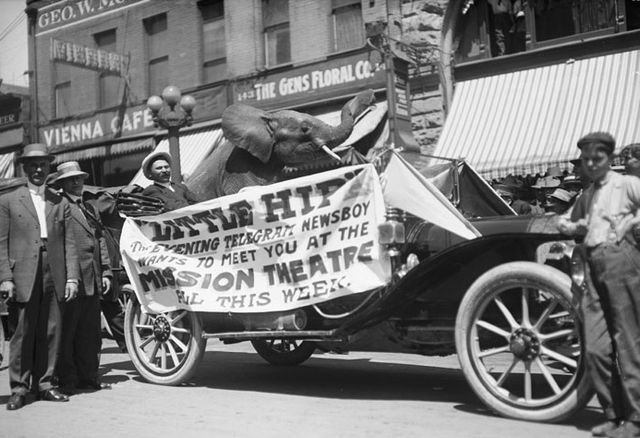Top Qs
Timeline
Chat
Perspective
Publicity stunt
Planned event to gain the attention of mass media From Wikipedia, the free encyclopedia
Remove ads
In marketing, a publicity stunt is a planned event designed to attract the public's attention to the event's organizers or their cause. Publicity stunts can be professionally organized, or set up by amateurs.[4] Such events are frequently utilized by advertisers and celebrities, many of whom are athletes and politicians. Stunts employing humour and pranks have been regularly used by protest movements to promote their ideas and campaigns as well as challenge opponents.[5]



Organizations sometimes seek publicity by staging newsworthy events that attract media coverage. They can be in the form of groundbreakings, world record attempts, dedications, press conferences, or organized protests. By staging and managing these types of events, the organizations attempt to gain some form of control over what is reported in the media. Successful publicity stunts have news value, offer photo, video, and sound bite opportunities, and are arranged primarily for media coverage.[6]
It can be difficult for organizations to design successful publicity stunts that highlight the message instead of burying it. The importance of publicity stunts is for generating news interest and awareness for the concept, product, or service being marketed.[7]
Remove ads
Notable examples
Summarize
Perspective
JP Morgan and Ringling Brothers
In 1933, J.P. Morgan Jr. was summoned to appear before Senate Banking and Currency Committee due to their suspicions of his previous banking activity throughout the financial crash. During the congressional hearings, U.S. Senator Carter Glass remarked that the proceedings had turned into a circus as things had begun to appear out of hand. The Ringling Brothers as well as Barnum & Bailey Circus were both in D.C. at the time of the hearing. Thus, they interpreted Senator Glass' remarks as an invitation and asked their press agent to place a female circus dwarf named Lya Graf, on Morgan Jr.'s lap during one of the hearings. While the addition of the small lady surprised Morgan and infuriated Glass, it also gained significant publicity for Ringling Brothers Circus.[8]
Calendar Girls
In 1999, a group of 11 women from the Women's Institute (in Yorkshire, UK) stripped for a calendar to raise money for the Leukaemia Research Fund. Setting a goal of $5,000, the group of Women's Institute women feared that they would struggle to sell even a 1,000 copies.[9] The calendar was eventually released on April 12, 1999, and featured all 11 women posing nude – obscured by baked goods, flower arrangements, sewing adornments, teapots, song sheets, and even a grand piano. Despite leaving people of this time stunned, over 800,000 copies of the calendar were sold worldwide. After its initial release in 1999, the calendar raised over 5 million euros or over 4.8 million U.S dollars. This publicity stunt eventually went on to inspire a multitude of media productions including a British comedy film, titled Calendar Girls[10] in 2003, a West End show in 2009, and a musical production in 2012, titled The Girls.[9] Tricia Stewart, one of the original calendar girls, also known as Miss October, even went on to publish her own autobiography, Calendar Girl, in which she retells the initial creation of the publicity stunt and how it changed their lives forever.[9]
IHOP and "IHOb"
In 2018, American restaurant chain IHOP, an acronym for International House of Pancakes, briefly changed their name to IHOb, or International House of Burgers.[11] The stunt aimed to promote the restaurant's new line of burgers.[12] A spokeswoman for the company told The Washington Post that the stunt was intended to "get people talking about, and thinking differently about, IHOP", which was primarily known as a pancake house that served only breakfast.[13] The company changed their name back to IHOP that same month.[11] The name change helped IHOP sell four times more burgers after the campaign compared to before.[14]
Remove ads
See also
References
Wikiwand - on
Seamless Wikipedia browsing. On steroids.
Remove ads
